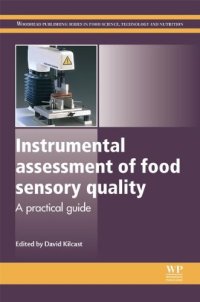
Ebook: Instrumental assessment of food sensory quality: A practical guide
Author: David Kilcast
- Genre: Technique // Food Manufacturing
- Tags: Пищевая промышленность, Управление качеством и безопасность продуктов питания, Сенсорный анализ
- Series: Woodhead Publishing Series in Food Science Technology and Nutrition
- Year: 2013
- Publisher: Woodhead Publishing
- Language: English
- pdf
Consumer enjoyment of food and drink products is strongly determined by sensory quality. Therefore, instrumental measurements of sensory quality are of growing importance in both complementing data provided by sensory panels and in providing valuable information in situations where sensory panels are not feasible. The editor and contributors review the range and use of instrumental methods for measuring sensory quality by covering the principles and practice of food sensory quality assessment and looking at the instrumental assessment of particular foods.
After an introductory chapter, part one goes on to explore the principles and practice of the assessment and analysis of food appearance, flavor, texture and viscosity. Part two reviews advances in methods for instrumental assessment of food sensory quality, such as food color measurement using computer vision, gas chromatography-olfactometry (GC-O), electronic noses and tongues for in vivo food flavor measurement, and non-destructive methods for food texture assessment. Further chapters highlight in-mouth measurement of food quality and emerging flavor analysis methods for food authentication. Finally, the third, and final, section focuses on the instrumental assessment of the sensory quality of particular foods and beverages including meat, poultry and fish, baked goods, dry crisp products, dairy products, fruit and vegetables and wine, beer, and juices.
After an introductory chapter, part one goes on to explore the principles and practice of the assessment and analysis of food appearance, flavor, texture and viscosity. Part two reviews advances in methods for instrumental assessment of food sensory quality, such as food color measurement using computer vision, gas chromatography-olfactometry (GC-O), electronic noses and tongues for in vivo food flavor measurement, and non-destructive methods for food texture assessment. Further chapters highlight in-mouth measurement of food quality and emerging flavor analysis methods for food authentication. Finally, the third, and final, section focuses on the instrumental assessment of the sensory quality of particular foods and beverages including meat, poultry and fish, baked goods, dry crisp products, dairy products, fruit and vegetables and wine, beer, and juices.
Download the book Instrumental assessment of food sensory quality: A practical guide for free or read online
Continue reading on any device:

Last viewed books
Related books
{related-news}
Comments (0)